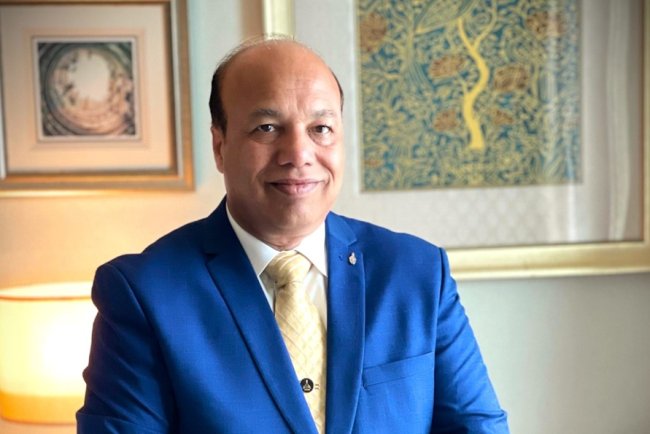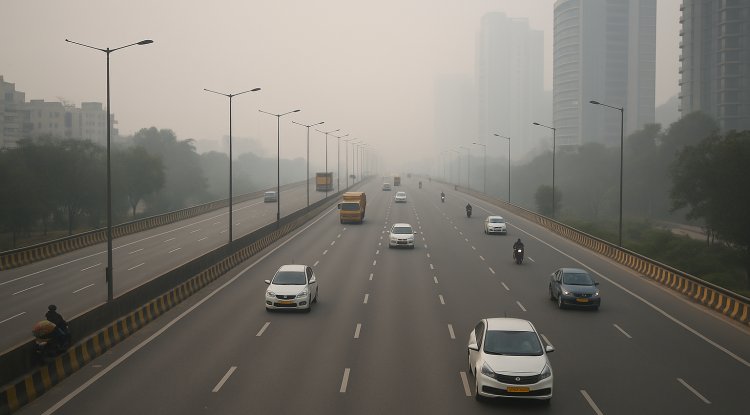We Use Tech Only After We Understand What The Plant Actually Needs: HortiRoad2India
Desh Ramntha, India Director at Dutch Greenhouse Delta and the Coordinator of HortiRoad2India, speaks about the technology and how it will address environmental and health concerns, enhance farmer income and more

Desh Ramnath brings a steady, seasoned voice to India’s fast-shifting horticulture landscape. As India Director at Dutch Greenhouse Delta and the Coordinator of HortiRoad2India, he works at the crossroads of European agri-innovation and India’s on-ground realities. In an interview with ResponsibleUs, he spoke about the technology and how it will address environmental and health concerns and enhance farmer income and more.
You mentioned SDG 6 and SDG 13. But from a common person’s point of view, what about SDG 2—zero hunger? That is equally important. And yet you're starting with strawberries, blueberries, and cherry tomatoes. Why begin there?
Zero hunger is very important, and targeting berries and cherry tomatoes is just a starting point. The lower-income groups are the most affected and the most left out when it comes to food. That is our biggest driver. But in any industry, in any country—India included—sustainability requires a change in behaviour, innovation, and money. Historically, what works is nudging: small steps at a time. To get the industry acquainted with the technology and to improve the technology, we first have to prove profitability, impact, and yields.
India has two challenges—not “problems” in this context—and the first is farmer income. But as of now, the farmer’s education level or understanding is limited. Most farmers don’t even know the retailer. And we ask them to grade without ever teaching them what grading even means. So, the farmer assumes: A is best, then B, C, D. He drives his lorry or bullock cart to the aggregator, and the buyer there rejects the grading, empties everything on the ground and regrades it. Produce gets heated, touched repeatedly, and exposed to soil, bacteria, and viruses. Then the same thing is repeated at markets like Vashi. That’s where harvest loss happens.
What if you told the farmer what to grow and how to grow it? That’s where the magic happens for us. We don’t want to compete yet, because the level isn’t there, and because farmers are scared. Most don’t have money. Their stress levels are extremely high. Ask them if they will invest in something worth 10 million—they won’t. We haven’t brought the prices down enough yet to make it practical. But we also face another challenge: sustainability.
We start here by learning together. The economics is simple: when the market becomes big enough, he will shift his factory to India. He won’t do it for two projects—he would lose money. But if he has ten projects, and eventually a couple of thousand, he will bring his factory here. Then you get new jobs for lower-income communities. Prices drop. And now you can move to the next step. We see this as a cascade—not just from us, but across the ecosystem. Competitors, partners, and agri-startups will come in, and hybrid solutions will be developed in India. That’s the vision. But we have to start somewhere. First, prove it works. Prove profitability. Don’t compete with farmers who aren’t ready yet.
Once a poor farmer sees another farmer—someone like him, not a salesperson—benefiting because he adopted the programme, he will believe him. That opens the door to FPOs. It’s a long cascade. But if you never start, you never build trust or proof. It’s like trying to sell a rocket in prehistoric times when people were scared of fire. Build a bicycle first. The bike earns trust. Then you move to a motorbike, then a car, then the rocket. Each step shortens the path. That’s how we see it in India. Many organisations already work with FPOs, support farmers, and even give short-term loans. So yes, one day they will invest in a 10-million system.
Greenhouses are criticised globally for emissions and environmental impact. You are launching a greenhouse model. How is yours different?
This is something we hear often. “Greenhouse emissions” in climate discussions refer to the planet heating up because trees are gone, and the ozone layer is thinning. The greenhouse we built for farming has nothing to do with climate-change emissions. The translation simply went wrong.
That’s why we prefer calling it controlled-environment agriculture. “Greenhouse emissions” borrowed the name because the physics is similar to heat trapped under a layer. That doesn’t mean agricultural greenhouses cause emissions. Some people assume the CO₂ inside a greenhouse gets trapped because the glass blocks it. That’s not what climate change is. Climate warming is caused by atmospheric gases preventing heat from escaping. Greenhouses actually remove CO₂ from the air and feed it to plants, which is good. The problem is too much CO₂ in the air because we cut down trees. In that sense, greenhouses help fight emissions, not cause them.
As for the technology, yes, people compare it to hydroponics. But hydroponics perception in India is limited. What we do is far more advanced, though the principle is similar. Soil isn’t involved. Plants grow on gutters inside the greenhouse. The gutters hold the plants, and each plant gets precisely the water it needs. About 60% drains out, gets collected, cleaned, sterilised, and reused. That is why the system saves more than 90% water.
The same applies to CO₂. One of the biggest improvements in the Netherlands wasn’t robots. It was shifting from soil-based growing to substrates in gutters. That made the biggest difference in sustainability. Depending on the climate, you choose different systems—you don’t need high-tech everywhere. But the first step, everywhere, is moving from soil to substrate. It reduces water use, fertiliser loss—everything.
On soil-health KPIs: we don’t grow in soil, so we don’t impact soil. The footprint is zero.
Your model still seems to serve the upper segment at €250 per square metre. How does this eventually reach mainstream farmers?
True, the current model mainly serves the upper segment. At €250 per square metre, the investment is high. The plan is to scale. The blueprint stays the same, services stay the same. Only the technology cost falls as adoption increases. But the core is farmer profitability.
The Netherlands leads in all forms of agriculture—from open-field to low, mid, and high-tech. We could sell a cheap, low-tech strawberry farm, but the farmer will go bankrupt because the economics won’t work. We study demand first. If a region needs cucumbers, we check our database: cucumbers require two parts CO₂, one part water, specific humidity, and specific lighting. Then we design the system that fits the climate and delivers profit.
We now know exactly what a cucumber needs. If the outside temperature is too high, bring it down by five degrees. If rainfall is insufficient, add water. If humidity is low, increase humidity. Based on those needs, we decide the right level of technology. Sometimes that means a simple net house. That alone gives profit because investment stays low, and conditions stay controlled.
Technology only makes sense when matched with the business case. I could sell a very cheap, low-tech strawberry farm, but I can guarantee the farmer will go bankrupt. For other crops, we already have tested systems and training infrastructure across levels.
The process is the same everywhere: we help with the business case, with financing, and then decide—based on market demand, climate, and crop needs—what level of technology is viable. Because we understand exactly what a plant needs to stay healthy and sustainable, we can advise whether a farmer should use mid-tech, low-tech, or remain in open-field with some basic tools.
Which regions in India are your starting points?
India has strong traditional agriculture in rural areas, but logistics are difficult. So our starting point is major urban centres—Bengaluru, Chennai, Hyderabad, Delhi, Mumbai, Kochi. These places have higher education levels, higher spending capacity, and more awareness. Retailers supplying these cities are more organised, so the ecosystem is ready.
Over time, we want to move into all regions. But that depends heavily on awareness. If people don’t understand why a sustainably grown strawberry or cucumber is worth even two cents more, they will buy the cheapest option—whether unhealthy or unsustainable. Many rural consumers still believe toxins disappear when you cook food. That shows the depth of the awareness gap.
People still believe cooking removes pesticides?
Yes. People genuinely believe you can cook food and the poison disappears. That mindset is precisely where the media must step in. It’s your responsibility to explain to society: stop poisoning yourselves and, by doing so, stop poisoning the planet.
India is the second-largest solar energy producer and fourth in renewable energy. But walk on the streets, and you still see people throwing litter anywhere. Awareness and civic sense are still low. This is where you come in. We are willing to take our responsibility, but we need your support. Without awareness, there is no business model—for the farmer or for us.
In the Netherlands, we run programmes called Feeding and Greening the World. Not feeding and greening the rich—feeding and greening the world. But it needs awareness, education, penetration—everything. We have to do this together. Now that we’ve found an entry point and partners like you, we can move forward.
Are there incentives or funding models planned to support adoption of your technology—for investors or buyers?
India has funding schemes. My plan is not to rely on them. Because for the Indian economy to grow, the farmer has to be profitable on his own. If a farmer earns more, he doesn’t need subsidies. That frees government money for schools, healthcare, and other priorities. A profitable farmer pays taxes, consumes more, grows the economy, and circulates benefits back into social goals.
If we can’t make a farmer profitable without subsidies, then we failed. The real magic is when he succeeds independently. That said, the government is willing to finance part of the technology, and we’re discussing that to get the system off the ground. But as long as the sector stays dependent on subsidy, the economy will stall at some point. Farmers must thrive independently—and they can. That’s where the dream lies.
What's Your Reaction?

















